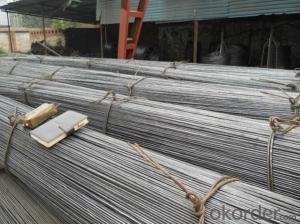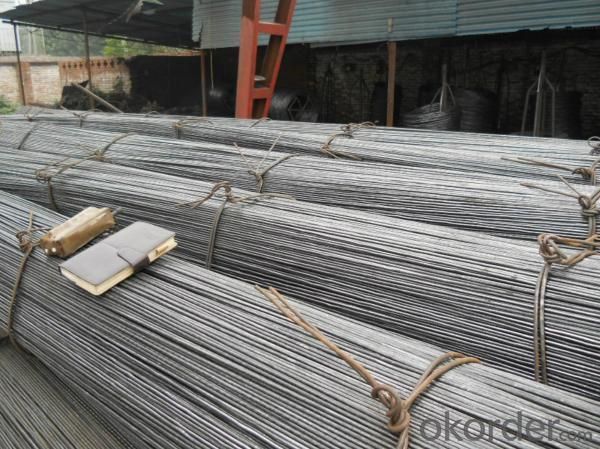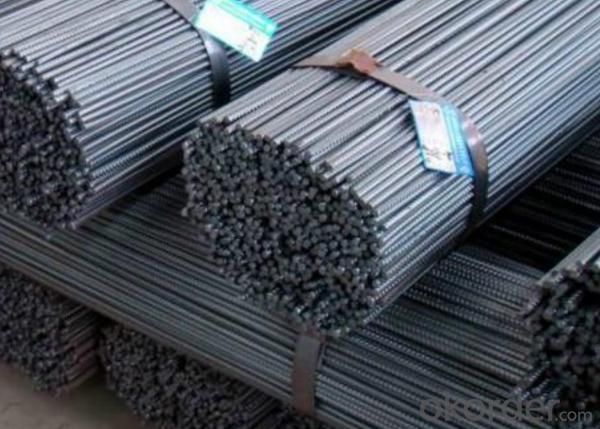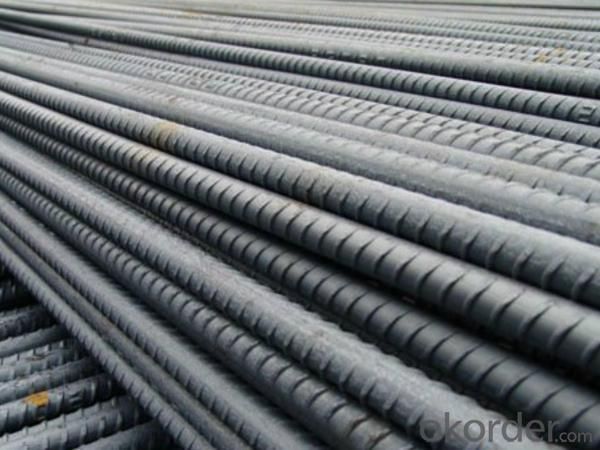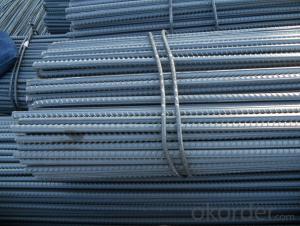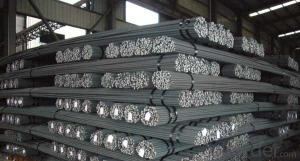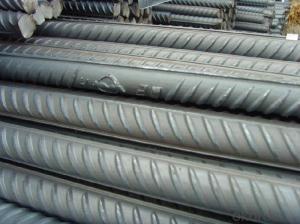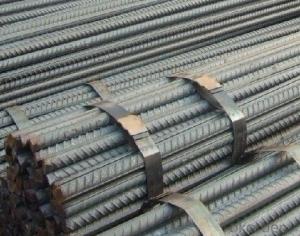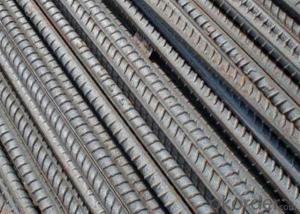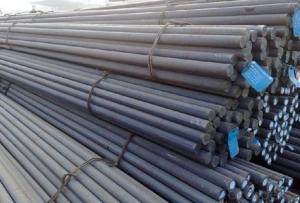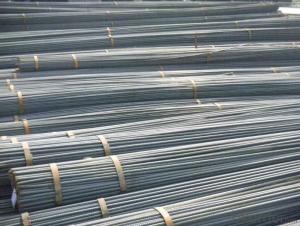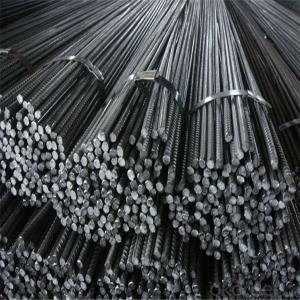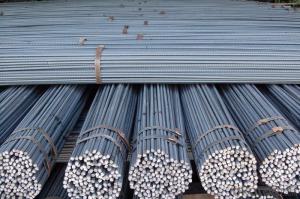Hot Rolled Steel HRB500 Deformed steel bar for Construction
- Loading Port:
- Tianjin
- Payment Terms:
- TT or LC
- Min Order Qty:
- 1000 m.t.
- Supply Capability:
- 10000 m.t./month
OKorder Service Pledge
OKorder Financial Service
You Might Also Like
Product Description:
OKorder is offering Hot Rolled Steel HRB500 Deformed steel bar for Construction at great prices with worldwide shipping. Our supplier is a world-class manufacturer of steel, with our products utilized the world over. OKorder annually supplies products to European, North American and Asian markets. We provide quotations within 24 hours of receiving an inquiry and guarantee competitive prices.
Product Applications:
Hot Rolled Steel HRB500 Deformed steel bar for Construction are ideal for structural applications and are widely used in the construction of buildings and bridges, and the manufacturing, petrochemical, and transportation industries.
Product Advantages:
OKorder's Hot Rolled Steel HRB500 Deformed steel bar for Construction are durable, strong, and resist corrosion.
Main Product Features:
· Premium quality
· Prompt delivery & seaworthy packing (30 days after receiving deposit)
· Corrosion resistance
· Can be recycled and reused
· Mill test certification
· Professional Service
· Competitive pricing
Product Specifications:
Standard | GB | HRB400 | |
Diameter | 6mm,8mm,10mm,12mm,14mm,16mm,18mm,20mm, 22mm,25mm,28mm,32mm,36mm,40mm,50mm | ||
Length | 6M, 9M,12M or as required | ||
Place of origin | Hebei, China mainland | ||
Advantages | exact size, regular package, chemical and mechanical properties are stable. | ||
Type | Hot rolled deformed steel bar | ||
Brand name | DRAGON | ||
Grade | Technical data of the original chemical composition (%) | ||||||
C | Mn | Si | S | P | V | ||
HRB400 | ≤0.25 | ≤1.60 | ≤0.80 | ≤0.045 | ≤0.045 | 0.04-0.12 | |
Physical capability | |||||||
Yield Strength (N/cm²) | Tensile Strength (N/cm²) | Elongation (%) | |||||
≥400 | ≥570 | ≥14 | |||||
Packaging & Delivery of Hot Rolled d-bar Steel
1. Packing: it is nude packed in bundles by steel wire rod
2. Bundle weight: not more than 3.5MT for bulk vessel; less than 3 MT for container load
3. Marks:
Color marking: There will be color marking on both end of the bundle for the cargo delivered by bulk vessel. That makes it easily to distinguish at the destination port.
Tag mark: there will be tag mark tied up on the bundles. The information usually including supplier logo and name, product name, made in China, shipping marks and other information request by the customer.
If loading by container the marking is not needed, but we will prepare it as customer request.
4. Transportation: the goods are delivered by truck from mill to loading port, the maximum quantity can be loaded is around 40MTs by each truck. If the order quantity cannot reach the full truck loaded, the transportation cost per ton will be little higher than full load.
5. Delivered by container or bulk vessel
FAQ:
Q1: Why buy Materials & Equipment from OKorder.com?
A1: All products offered byOKorder.com are carefully selected from China's most reliable manufacturing enterprises. Through its ISO certifications, OKorder.com adheres to the highest standards and a commitment to supply chain safety and customer satisfaction.
Q2: How do we guarantee the quality of our products?
A2: We have established an advanced quality management system which conducts strict quality tests at every step, from raw materials to the final product. At the same time, we provide extensive follow-up service assurances as required.
Q3: How soon can we receive the product after purchase?
A3: Within three days of placing an order, we will begin production. The specific shipping date is dependent upon international and government factors, but is typically 7 to 10 workdays.
Q4: What makes stainless steel stainless?
A4: Stainless steel must contain at least 10.5 % chromium. It is this element that reacts with the oxygen in the air to form a complex chrome-oxide surface layer that is invisible but strong enough to prevent further oxygen from "staining" (rusting) the surface. Higher levels of chromium and the addition of other alloying elements such as nickel and molybdenum enhance this surface layer and improve the corrosion resistance of the stainless material.
Q5: Can stainless steel rust?
A5: Stainless does not "rust" as you think of regular steel rusting with a red oxide on the surface that flakes off. If you see red rust it is probably due to some iron particles that have contaminated the surface of the stainless steel and it is these iron particles that are rusting. Look at the source of the rusting and see if you can remove it from the surface.
Images:
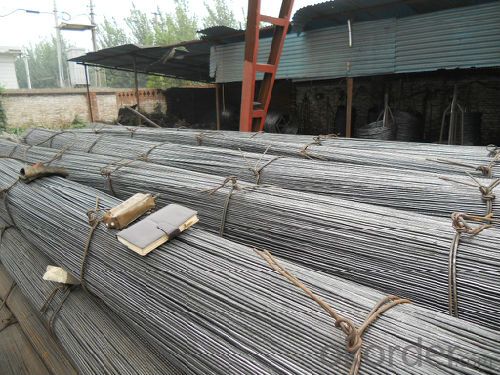
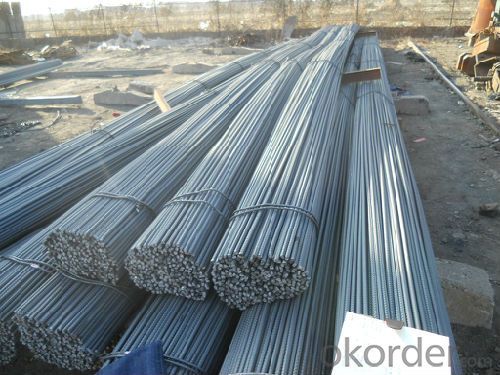
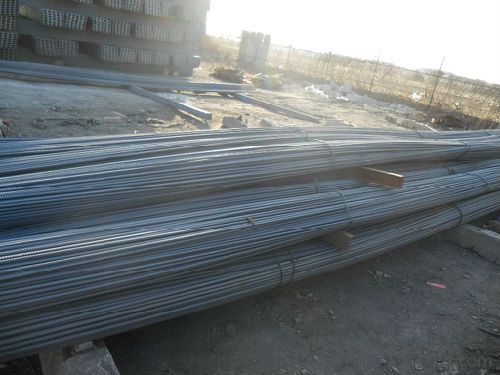
- Q: Are steel rebars suitable for use in earthquake-resistant structures?
- Indeed, steel rebars are a suitable choice for incorporation into earthquake-resistant structures. Commonly referred to as reinforcing bars, steel rebars are frequently utilized in construction projects to provide structural strength and reinforcement. They have been proven to effectively enhance the strength and ductility of concrete structures, rendering them more resistant to seismic forces. During the occurrence of an earthquake, structures are subjected to vigorous shaking and ground motion. Steel rebars play a pivotal role in evenly distributing and dissipating the energy generated by these seismic forces, thus decreasing the susceptibility of a structure to damage or collapse. Their utilization contributes to the overall enhancement of structural integrity and stability, empowering buildings and other infrastructure to endure the lateral and vertical forces associated with earthquakes. Furthermore, steel rebars possess exceptional tensile strength, which is paramount for seismic resistance. In contrast to concrete, which excels in compression but lacks resilience in tension, steel rebars furnish the necessary reinforcement to counteract tensile stresses induced by seismic activity. This capability to withstand both compression and tension renders steel rebars an optimal selection for earthquake-resistant structures. In addition, steel rebars can be configured and installed in a manner that provides additional ductility to a structure. Ductility denotes the capacity of a material to undergo deformation without fracturing. Structures exhibiting greater ductility can experience significant deformations and absorb energy during an earthquake, consequently diminishing the likelihood of catastrophic failure. Steel rebars are renowned for their elevated ductility, affording them the ability to effectively absorb and dissipate seismic energy. To conclude, steel rebars prove to be highly appropriate for inclusion in earthquake-resistant structures. Their strength, capacity to withstand both compression and tension, and exceptional ductility position them as indispensable components in guaranteeing the structural integrity and safety of buildings and infrastructure in regions prone to seismic activity.
- Q: Can steel rebars be used in non-structural applications?
- Yes, steel rebars can be used in non-structural applications. While rebars are primarily used to reinforce concrete structures, they can also be utilized in non-structural applications where additional strength or support is desired. These applications include garden stakes, fence posts, trellises, and other similar uses. The high tensile strength of steel rebars makes them suitable for these non-structural applications, as they can provide increased stability and durability. However, it is important to note that the sizing and specifications of rebars used for non-structural applications may differ from those used in structural applications.
- Q: What are the different types of steel rebars available?
- There are several types of steel rebars available, including standard carbon steel rebars, epoxy-coated rebars, galvanized rebars, stainless steel rebars, and composite rebars.
- Q: What are the different types of steel rebars used in dam constructions?
- There are several different types of steel rebars used in dam constructions, each with specific properties and applications. The most commonly used types include: 1. Mild Steel Rebars: These rebars are made from low carbon steel and are widely used in dam constructions due to their affordability and availability. They provide good tensile strength, but their corrosion resistance is relatively low. 2. High Strength Deformed (HSD) Steel Rebars: HSD rebars are made from carbon steel with added alloys such as vanadium or manganese. These rebars offer higher tensile strength and better corrosion resistance compared to mild steel rebars. They are commonly used in critical areas of the dam structure that require higher strength. 3. Epoxy-Coated Rebars: To enhance corrosion resistance, rebars can be coated with epoxy. This coating acts as a barrier against moisture and chemicals, reducing the risk of corrosion. Epoxy-coated rebars are commonly used in dam constructions where exposure to harsh environmental conditions is expected. 4. Stainless Steel Rebars: Stainless steel rebars are highly resistant to corrosion and are used in dam constructions where the structure is exposed to aggressive environments, such as saltwater or chemical-laden water. They are more expensive than other types of rebars but offer superior durability. 5. Galvanized Rebars: Galvanized rebars are coated with a layer of zinc, providing excellent corrosion resistance. They are commonly used in dam constructions where the structure will be exposed to water or moisture for extended periods. The selection of the appropriate type of steel rebar for dam construction depends on factors such as the specific requirements of the project, the expected environmental conditions, and the budget. An engineering team will carefully evaluate these factors to determine the most suitable type of steel rebar to ensure the longevity and structural integrity of the dam.
- Q: Can steel rebars be used in structures with high resistance to abrasion?
- Yes, steel rebars can be used in structures with high resistance to abrasion. Steel rebars are commonly used in reinforced concrete structures to add strength and durability. The steel used in rebars is specifically chosen for its high tensile strength and resistance to various environmental conditions. While rebars themselves may not be inherently resistant to abrasion, the concrete that surrounds the rebars provides protection against abrasion. When properly designed and constructed, reinforced concrete structures with steel rebars can withstand high levels of abrasion and maintain their structural integrity over time. Additionally, epoxy-coated rebars can be used in areas with high abrasion or corrosive environments to provide an extra layer of protection against both abrasion and corrosion.
- Q: What is the process of joining steel rebars together?
- The process of joining steel rebars together is commonly done through methods such as overlap splicing, mechanical splicing, and welding. In overlap splicing, two rebars are overlapped and tied together using wire or steel straps. Mechanical splicing involves using couplers or threaded connectors to join rebars together. Welding, on the other hand, involves melting the ends of two rebars and fusing them together using heat. Each method has its own advantages and considerations, depending on factors like the structural requirements and project specifications.
- Q: Can steel rebars be used in decorative or artistic applications?
- Yes, steel rebars can be used in decorative or artistic applications. They can be shaped, welded, and bent to create unique and visually appealing designs. Steel rebars can be used in sculptures, furniture, architectural features, and other artistic projects, adding a modern and industrial touch to the overall aesthetic.
- Q: What is the maximum spacing allowed between steel rebars in concrete slabs?
- The maximum spacing allowed between steel rebars in concrete slabs typically depends on various factors such as the thickness of the slab, the load it will bear, and the design requirements. However, as a general guideline, the maximum spacing is often specified to be around 3 times the slab thickness or 18 inches (whichever is less) to ensure proper reinforcement and structural integrity.
- Q: Thread steel generally used for more?
- Mainly used for reinforcement of reinforced concrete and prestressed concrete structures. It is one of the most widely used kinds of steel in civil engineering.
- Q: How do steel rebars impact the overall flexibility of a structure?
- Steel rebars, also referred to as reinforcing bars, play a crucial role in enhancing the overall flexibility of a structure. These bars are typically utilized in reinforced concrete structures to bolster tensile strength and enhance the structural integrity of the building. The integration of steel rebars in concrete significantly augments the flexibility of a structure. Concrete itself possesses strength in compression but weakness in tension. By incorporating rebars, the structure becomes more adept at withstanding tensile forces and resisting bending or deformation caused by external loads or environmental factors. The rebars function as reinforcement by assimilating and dispersing tensile forces throughout the structure, aiding in the prevention of cracks and ensuring a more uniform distribution of stress. This is particularly vital in regions prone to seismic activity or high wind loads, where structures must possess the ability to flex and absorb the energy exerted upon them. Furthermore, the presence of steel rebars also permits the creation of thinner and lighter concrete sections. This contributes to the overall flexibility of the structure by reducing the dead load, rendering it more responsive and adaptable to diverse conditions. In summary, steel rebars have a significant impact on the overall flexibility of a structure by furnishing tensile strength, averting cracks, distributing stress, and enabling the implementation of lighter and thinner concrete sections. By enhancing the structural integrity and resilience, the inclusion of rebars ensures that the building can withstand external forces while preserving its stability and flexibility, ultimately contributing to its longevity and safety.
Send your message to us
Hot Rolled Steel HRB500 Deformed steel bar for Construction
- Loading Port:
- Tianjin
- Payment Terms:
- TT or LC
- Min Order Qty:
- 1000 m.t.
- Supply Capability:
- 10000 m.t./month
OKorder Service Pledge
OKorder Financial Service
Similar products
Hot products
Hot Searches
Related keywords
